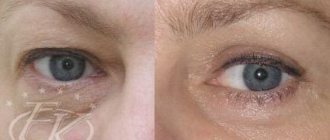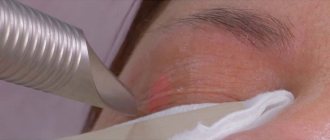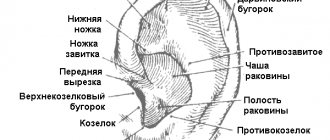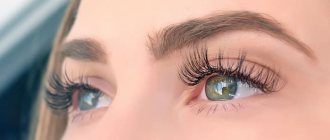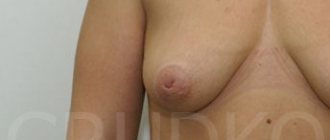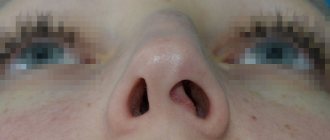The standards of female beauty are constantly being revised, but changing fashion is afraid to touch the eyes. They, like hundreds of years ago, must be clearly defined, slightly elongated with raised outer corners. This is exactly what the Egyptian queens had: the beautiful Nefertiti, the wise Hatshepsut and the calculating Cleopatra.
Centuries have passed since the times of Ancient Egypt, but beautiful eyes still make men’s hearts tremble. A mysterious look from under fluffy eyelashes beckons with the promise of tender passion, which is impossible to resist.
Unfortunately, not everyone has beautiful eyes that are slightly elongated towards the temples. And even if you received such a gift, time will mercilessly ruin it. The first changes are noticeable already at the age of 30 - the eyelids become heavy, and the outer corners creep down. As a result, the look speaks of only one passion - the desire to finally get some sleep. Canthoplasty, an operation to change the shape of the eyes, will help restore the exciting expressiveness of your eyes.
CANTHOPLASTY PHOTO
Look at the photos before and after canthoplasty in the “Photo Gallery” section. There are photographs of the initial condition of the patients and the result of the operation after the recovery period. Next to each photo is the name of the plastic surgeon who managed to achieve this effect.
What is eye canthoplasty?
This is an operation to correct the shape and shape of the eyes. Minor surgery can alter the incision or narrow it for an owl-eye effect. There are many indications for canthoplasty; the operation is recommended for anyone who wants to make their eye shape beautiful.
You can spend time on makeup every day, correcting aesthetic imperfections with cosmetics, but it is much easier to have surgery once and get the desired eye shape. The effect of laser surgery lasts up to 10 years! Canthoplasty can be repeated if desired.
Canthopexy and canthoplasty: what is it?
Age-related changes begin with the eyes: first, small facial wrinkles appear around the eyes - “crow’s feet” in the outer corners, which only get worse over time, especially, sadly, in the most joyful and cheerful people. With age, the outer corners of the eyes also tend to “sink” downwards, which, combined with weakened eyelid skin, gives the impression of a “tired”, “heavy” look. And all this together can greatly spoil your mood, even if you maintain excellent shape and take good care of yourself, and generally look young and beautiful...
These age-related changes have a physiological basis: with age, the thin tendons of the outer corners of the eyes stretch and become weaker, and therefore are no longer able to hold the skin in the corners of the eyes as effectively as before. And unfortunately, since this is not a matter of the condition of the skin and its tone, this problem cannot be solved using cosmetology: it can only be solved surgically.
What is canthopexy?
Canthopexy of the eyelid (from the Latin “canthus” - angle) is a plastic surgery that is part of the complex operation “blepharoplasty” and allows you to “raise” the outer corners of the eyes, and thereby eliminate the effect of “fatigue” and “crow’s feet”. There are two types of canthopexy: lateral (in which the outer corner of the eye is corrected) and medial (in which the inner corner is corrected).
Canthoplasty and canthopexy: what is the difference?
Canthopexy is often combined with canthoplasty. Canthoplasty is an operation whose purpose is to change the shape and shape of the eyes.
Blepharoplasty with canthopexy: indications for surgery
Indications for canthopexy are not only age-related changes: canthopexy and canthoplasty are also a way to solve some congenital problems with the shape and shape of the eyes.
- Drooping of the outer corner of the eyes
- “Sagging” of the skin of the eyelids (“ptosis” of the eyelids) – both upper and lower
- "Tired" or "sullen" look
- The effect of “bulging” eyes, which often occurs in people with early-onset myopia
- The patient’s desire to change the shape of the eyes (for example, if the eyes are round or have an “Asian” shape, this can be changed using canthoplasty)
- Correction of the size of the palpebral fissure (in some cases it needs to be reduced and in such cases the operation “blepharomyosis” is performed)
- “Eversion” of the lower eyelid (both the result of previously unsuccessful operations, and the result of age-related changes or diseases) - in this case, canthopexy of the lower eyelids
Upper and lower blepharoplasty with canthopexy: how the operation works
Canthopexy is performed through a small incision in the crease above the upper eyelid: through this incision, the weakened tendon is pulled up and attached to the periosteum using self-dissolving sutures. If there is excess skin, it is removed. If there are excess tendons resulting from their excessive stretching, they are also excised, and the ends of the tendons are attached to the muscle and fixed to the periosteum. As a result of these manipulations, the corners of the eyes are raised, the skin of the eyelids is tightened, and the eyes seem to “open” and become larger, and the look loses the effect of “fatigue” and becomes more open and “youthful.”
Canthopexy before and after photos:
Canthopexy before and after
Canthopexy Moscow: prices and reviews
Canthopexy reviews. We do not specifically ask our patients to leave reviews, since plastic surgery is a rather intimate thing, and many people prefer not to advertise the fact of plastic surgery. However, recently, our patients are increasingly leaving their own reviews on our pages on social networks in the public domain: we nevertheless decided to publish these reviews on our website.
Canthopexy prices. Canthopexy is considered as part of blepharoplasty, since it is always combined with some other manipulations. Therefore, the cost of canthopexy and canthoplasty is included in the cost of a complex blepharoplasty operation.
If you have questions, you can ask them in the Q&A section.
You can make an appointment for a consultation with plastic surgeon A.P. Panayetov in Moscow by phone (viber, whatsapp) or through the feedback form on the website:
Lateral canthoplasty
This operation involves correction of the outer corners of the eye. The lateral ligament consists of two parts - superior and inferior. The correction solves several aesthetic problems:
- eliminates the problem of insufficient eye length;
- relieves visual strabismus;
- helps to remove the effect of a gloomy look due to raised corners of the eyes, etc.
Most often, lateral canthoplasty is performed, but if necessary, the operation can be combined with medial correction.
METHODS OF SURGICAL INTERVENTION
Figure 5. Lateral canthoplasty with division of the inferior lateral canthal ligament.
Figure 6. Lateral canthoplasty with division of the superior and inferior lateral canthal ligament.
Depending on the task, doctors can perform the operation in combination with various manipulations. There are three main approaches, each of which can be combined with blepharoplasty for significant rejuvenation. 1. Lateral. The ligament is cut, lifted and secured. It is sutured to the periosteum or immediately to the edge of the bone of the orbital zone. The method is suitable for changing the shape or shape of the eyes. All manipulations take place through an incision not up to 1 cm long. Access in the natural crease of the eyelid and the surgeon’s experience make the scar invisible. Only a professional can recognize the operation performed; for others, the reason for the sudden transformation will remain a mystery.
Figure 7. Canthoplasty with eyelid shortening and cartilage modeling.
2. Surgery to change the shape of the cartilage. The result is not only a lifting of the corner of the eye, but also a reduction in the size of the lower eyelid. Necessary for sagging eyelids, which makes the face look tired.
Figure 8. Cantomyoplasty with cutting out a muscle flap.
3. Cantomyopexy. The doctor cuts out part of the orbicularis muscle, securing the resulting flap to the tendon plate of the temporalis fascia.
REVIEWS ABOUT CANTHOPLASTY
“Many thanks to the plastic surgeon I.S. Kochneva.
and her entire team. These are true professionals who not only do their job efficiently, but are also very attentive to their patients. My 57-year-old mother came to the clinic. She underwent blepharoplasty, SMAS-plasty (this is a tightening of the skin of the neck and lower part of the face). Then resection of the DAO was performed and facial lipofilling was performed. Mom has always been a beautiful, impressive woman, but age has given her face a tired look. Ilona Sergeevna and her team were able to fix this. At the same time, my mother remained herself, her facial features did not change, she simply became young and beautiful again. Now the address “grandmother” does not really suit her - she is a beautiful, well-groomed woman with an open look. Natalya, 57 years old.” Read other patient reviews about canthoplasty performed by surgeons at the Abrielle Clinic.
Select the operation you are interested in in the catalog and see what patients think about the doctors, the service and the results of the operation.
Medial canthoplasty
If the surgeon performs manipulations in the area of the inner corner, then such a correction is called medial canthoplasty. The need for this type of intervention arises when there is pathology of skin folds, or the presence of visual defects: scars, cicatrices, etc.
In any case, the course of the operation is determined during the consultation. After the examination, the doctor will determine which ligaments need to be affected to achieve the desired result. Canthoplasty can be combined with other corrective procedures, such as blepharoplasty.
What results can canthoplasty help achieve?
Typically, patients turn to canthoplasty for aesthetic reasons, changing the shape of the eyes or eliminating the effect of a bulging gaze. The operation helps to give expressiveness and clarity to the look, solve the problem of drooping corners and heavy gloomy gaze. Correction is often carried out to eliminate age-related changes in the eye area that occur after 40-45 years.
In addition to aesthetic problems, canthoplasty solves medical problems:
- increases the palpebral fissure that is too narrow (consequences of injuries and burns);
- relieves high pressure on the eyeball during inflammation and other diseases;
- eliminates asymmetry and various birth defects.
What do you need to know about lateral and medial canthoplasty?
This is a simple operation; for experienced surgeons, changing the shape of a patient's eyes is as easy as changing their color using regular lenses. The correction is performed under local or general anesthesia; the choice depends on the individual characteristics of the patient and his personal preferences.
Canthoplasty is an independent type of correction, but if necessary, it can be part of a program that includes other procedures: canthopexy, blepharoplasty, etc.
After the operation, there are no traces of the intervention; the scars lighten and after a few months completely disappear, hiding in the natural crease of the eyelid.
The effect of the correction can be assessed 2 weeks after surgery, when the recovery period has passed. The result will delight you for many years. Come to the El.En. Clinic and we will help you achieve the results you want, offering the services of experienced, first-class surgeons.
Recovery after canthoplasty
How can we ensure that the recovery period is as short as possible and that complications do not interfere with the healing process? Our experts recommend, first of all, to carefully follow all the recommendations given to the patient before and after the operation. To make sure of this, read canthoplasty reviews
our grateful patients.
In addition, patients are recommended to:
- Do not use creams and decorative cosmetics for 2 weeks.
- Refrain from alcoholic beverages and smoking cigarettes.
- Do not look at the computer or TV screen, do not read books.
- Do not use contact lenses for 4 weeks.
- Wear sunglasses for 1-2 months.
- Do not visit the bathhouse, sauna or swimming pool.
- Do not play sports or perform strenuous physical activity.


